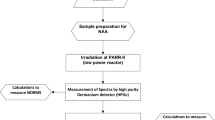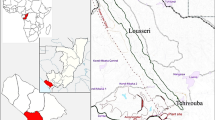Abstract
Instrumental neutron activation analysis (INAA) has been employed forthe determination of arsenic in samples of water bodies at Konongo an oldmining town in the Ashanti region of Ghana and its surrounding towns and villages.In some of the water samples, significant levels of arsenic were recordedbut others gave no indication of the metal. The precision and accuracy ofthe method was evaluated using real ore samples and standard reference materials.The accuracy of the method was found to be within ±6%. The averagearsenic levels found in the water samples ranged between 0.04 and 12.2 mg/l.Untreated ore and tailing samples were also analysed for arsenic. The surfaceore gave an arsenic concentration of 4,628±97 ppm while that of thebottom ore was 2,978±69 ppm. For the tailing samples, the range ofarsenic level was 1,776 to 1,787 ppm. It was observed that the upper sink(i.e., the surface portion of the ore) showed higher levels of arsenic thanthe lower one (i.e., bottom portion of the ore).
Similar content being viewed by others
References
G. O. Kesse, The Mineral and Rock Resources of Ghana, A. A. Balkema, Rotterdam, 1985.
L. W. Newland, A Handbook on Environmental Chemistry, Vol. 3, Part B, Springer Verlag, Berlin, 1982, p. 25.
G. L. Walbolt, A Handbook on Environmental Chemistry, Health Effects of Environmental Pollutants, Vol. 3, Part B, Springer Verlag, Berlin, 1982, p. 35.
Environmental Health Criteria, 18, World Health Organization, (WHO), Geneva, 1981, p. 18.
D. Carbo, Y. Serfor-Armah, Arsenic pollution in streams and sediments in the Obuasi Area, Proc. of UST-IDRC'97 National Symp., Kumasi, Ghana, April, 1997, p. 114.
G. A. Manful, M. Verloo, Determination of arsenic in hair and nails of some ine workers in Obuasi, Proc. 4th Intern. Conf. of Environmental Contamination, Barcelona, 1990.
Y. Amoyaw-Osei, The Effects of Gold Mining Gaseous Emissions on Fauna and Flora, B. Sc. Thesis, University of Science and Technology, Kumasi, Ghana, 1986.
S. K. Amasa, Health Perspective, Vol. 12, Arsenic Pollution at Obuasi Gold Mine and Surrounding Countryside, 1975, p. 131.
Y. Serfor-Armah, Determination of Total Arsenic in Sediments from Obuasi Gold Mines, M. Phil. Thesis, University of Ghana, Legon, 1994, p. 85.
Global Environmental Monitoring Systems Water Operational Guide, World Health Organization (WHO), Geneva, 1987, Chap. 1, p. 10.
L. Wang, Multi-purpose-ray Spectrum Analysis Software, IAE/ SPAN 5.0, 1995.
Germanium Detectors, User's Manual, Canberra Industries, 1993.
E. K. Osae, B. J. B. Nyarko, Y. Serfor-Armah, E. O. Darko, J. Radioanal. Nucl. Chem., 242 (1999) 617.
Guidelines for Drinking Water Quality, Recommendations, Vol. 1, WHO, Geneva, 1985.
J. S. Jones, Soil. Sci., 60 (1945) 227.
Author information
Authors and Affiliations
Rights and permissions
About this article
Cite this article
Nyarko, B.B. Determination of arsenic in some water bodies, untreated ore and tailing samples at Konongo in the Ashanti region of Ghana and its surrounding towns and villages by instrumental neutron activation analysis. Journal of Radioanalytical and Nuclear Chemistry 249, 581–585 (2001). https://doi.org/10.1023/A:1013246231569
Issue Date:
DOI: https://doi.org/10.1023/A:1013246231569




